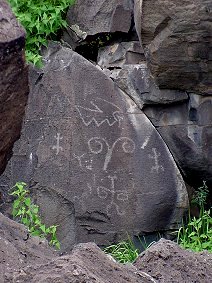Casa Malpaís
|
Casa Malpaís Archaeological Park and Museum
|
|

The Kiva
|
|
| Nearest city | Springerville, Arizona |
|---|---|
| Coordinates | 34°09′N 109°18′W / 34.150°N 109.300°WCoordinates: 34°09′N 109°18′W / 34.150°N 109.300°W |
| Built | 1250 |
| NRHP Reference # | 66000936 |
| Significant dates | |
| Added to NRHP | October 15, 1966[1] |
| Designated NHL | July 19, 1964[2] |
Casa Malpaís is an archaeological site of the Ancient Pueblo Peoples located near the town of Springerville, Arizona. The site is a nationally recognized archaeological site[3] and was declared a National Historic Landmark in 1964.[2][4]
Contents
Description[edit]
Casa Malpaís was built around 1260 and was inhabited until about 1400, meaning that the site dates from the Pueblo III to the Pueblo IV Era.[2] It is one of the latest dated Mogollon sites. The name Casa Malpaís has been misinterpreted to mean House of the Badlands, but the name actually refers to the type of volcanic vesicular basalt rock, or Malapi, which the site is built upon. The Springerville volcanic field contains over 400 volcanoes within a fifty-mile radius of Springerville, making it the third largest volcanic field in the continental United States.[5]
Unique and unusual features characterize the site. The Great Kiva, painstakingly constructed of volcanic rock, is the centerpiece. A steep basalt staircase set into a crevice of the high basalt cliff wall leads to the top of the mesa.
Both the Hopi and Zuni Indian tribes still consider Casa Malpaís a sacred ancestral place.
The site is at an elevation of 7,000 feet and the pueblo is perched atop terraces on front of basalt cliffs. These cliffs were formed from lava flow from an ancient volcano. Around 1240, a 60-room pueblo, solar calendar, and Great Kiva were built by the people. The site was believed to be abandoned by 1350. [6]
Artifacts were excavated and collected over time. The Casa Malpaís collection includes 156 boxes of potsherds and other artifacts from the ruins. Special butterfly collection. Most of the artifacts found in the 1990s are displayed in the Casa Malpaís museum.[7]
Solar Calendar[edit]
This feature consists of a low stone wall enclosing a space 26 meters in diameter, with 5 gates. Part of the structure has been restacked, indicating an approximate possible height of 1.2 meters. "An opening on the structure's northern side appears to be oriented to true north" (Zoll 2012) Another, on the southwest side of the structure, is offset to allow a distinctive rectangular shaft of light to enter in a direct line with the wall during sunset at summer solstice (Zoll 2012, p. 15). At winter solstice, the shaft of light once again enters through the gate and extends to about the middle of the enclosure (Zoll 2012, p. 14). During the equinoxes, the sun enters again through the gate and "produces a distinctive rectangular shaft of light" (Zoll 2012, p. 15).
Outside this circular feature, is a Bear Claw petroglyph, which at vernal equinox sunset, fits into a shaft of light produced by a natural rock grouping. " Both the Hopi and Zuni have bear clans or bear societies who may have created this image for reasons unknown"(Zoll 2012 p. 18).
Discovery[edit]
The first visit to Casa Malpaís by a professional anthropologist was in 1883, when Frank Cushing, an anthropologist living at Zuni Pueblo, New Mexico, visited a site at "El Valle Redondo on the Colorado Chiquito", and was impressed by what he termed "the fissure type pueblo" he found there. In his journal he sketched dry masonry bridging fissures, upon which the pueblo is constructed.[8]
Casa Malpais Visitor Center and Museum[edit]
The Casa Malpais Visitor Center and Museum'is located on Main Street in Springerville, Arizona. The museum displays artifacts found at Casa Malpais and offers guided tours of the site that originate at the museum.
References[edit]
- ^ National Park Service (2007-01-23). "National Register Information System". National Register of Historic Places. National Park Service.
- ^ a b c "Casa Malpais Site". National Historic Landmark summary listing. National Park Service. 2007-09-27. Archived from the original on 2009-03-03.
- ^ Ancient Mogollon (Western Pueblo) Solstice And Equinox, Sun Watch Station And Ruins: "Casa Malpais" Archaeological Park at delange.org
- ^ Helene R. Dunbar (10 August 1987). "National Register of Historic Places Inventory-Nomination: Casa Malpais (AZ Q:15:3)" (PDF). National Park Service.
- ^ Coronado Trail Scenic Byway: Casa Malpais Indian Ruins and Archaeological Park, AZ, National Scenic Byways Program
- ^ [1], America's Byways
- ^ "Arizona Cultural Inventory Project". Division of the Secretary of State. Archived from the original on 12 October 2012. Retrieved 16 April 2012.
- ^ Casa Malpais Archaeological Park Springerville, Arizona, White Mountains Online
- ^ Zoll, Kenneth (2012). "A Cultural Astronomy Study of the Casa Malpais National Historic Landmark Site in Springerville, Arizona". The Arizona Archaeologist. 38: 1–26.
External links[edit]
 Media related to Casa Malpaís at Wikimedia Commons
Media related to Casa Malpaís at Wikimedia Commons- Casa Malpais Archaeological Park and Museum
- Local guide to Casa Malpais Archaeological Park
- Archaeological museums in Arizona
- Archaeological sites on the National Register of Historic Places in Arizona
- Buildings and structures in Apache County, Arizona
- Former Native American populated places in the United States
- Former populated places in Apache County, Arizona
- Museums in Apache County, Arizona
- Native American history of Arizona
- Native American museums in Arizona
- National Historic Landmarks in Arizona
- Oasisamerica cultures
- Puebloan buildings and structures
- Religious places of the indigenous peoples of North America
- Ruins in the United States
- National Register of Historic Places in Apache County, Arizona
- Populated places on the National Register of Historic Places in Arizona



